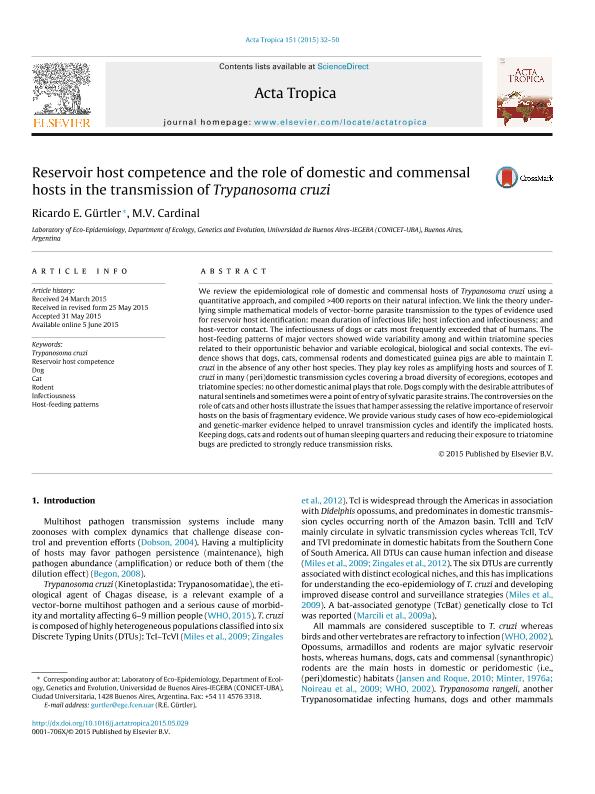Mostrar el registro sencillo del ítem
dc.contributor.author
Gurtler, Ricardo Esteban

dc.contributor.author
Cardinal, Marta Victoria

dc.date.available
2018-09-19T19:20:45Z
dc.date.issued
2015-03
dc.identifier.citation
Gurtler, Ricardo Esteban; Cardinal, Marta Victoria; Reservoir host competence and the role of domestic and commensal hosts in the transmission of Trypanosoma cruzi; Elsevier Science; Acta Tropica; 151; 1; 3-2015; 32-50
dc.identifier.issn
0001-706X
dc.identifier.uri
http://hdl.handle.net/11336/60292
dc.description.abstract
We review the epidemiological role of domestic and commensal hosts of Trypanosoma cruzi using aquantitative approach, and compiled >400 reports on their natural infection. We link the theory under-lying simple mathematical models of vector-borne parasite transmission to the types of evidence usedfor reservoir host identification: mean duration of infectious life; host infection and infectiousness; andhost-vector contact. The infectiousness of dogs or cats most frequently exceeded that of humans. Thehost-feeding patterns of major vectors showed wide variability among and within triatomine speciesrelated to their opportunistic behavior and variable ecological, biological and social contexts. The evi-dence shows that dogs, cats, commensal rodents and domesticated guinea pigs are able to maintain T. cruzi in the absence of any other host species. They play key roles as amplifying hosts and sources of T. cruzi in many (peri)domestic transmission cycles covering a broad diversity of ecoregions, ecotopes andtriatomine species: no other domestic animal plays that role. Dogs comply with the desirable attributes ofnatural sentinels and sometimes were a point of entry of sylvatic parasite strains. The controversies on therole of cats and other hosts illustrate the issues that hamper assessing the relative importance of reservoirhosts on the basis of fragmentary evidence. We provide various study cases of how eco-epidemiologicaland genetic-marker evidence helped to unravel transmission cycles and identify the implicated hosts. Keeping dogs, cats and rodents out of human sleeping quarters and reducing their exposure to triatominebugs are predicted to strongly reduce transmission risks.
dc.format
application/pdf
dc.language.iso
eng
dc.publisher
Elsevier Science

dc.rights
info:eu-repo/semantics/openAccess
dc.rights.uri
https://creativecommons.org/licenses/by-nc-nd/2.5/ar/
dc.subject
Dogcat
dc.subject
Host-Feeding Patterns
dc.subject
Reservoir Host Competence
dc.subject
Rodentinfectiousness
dc.subject
Trypanosoma Cruzi
dc.subject.classification
Otras Ciencias Biológicas

dc.subject.classification
Ciencias Biológicas

dc.subject.classification
CIENCIAS NATURALES Y EXACTAS

dc.title
Reservoir host competence and the role of domestic and commensal hosts in the transmission of Trypanosoma cruzi
dc.type
info:eu-repo/semantics/article
dc.type
info:ar-repo/semantics/artículo
dc.type
info:eu-repo/semantics/publishedVersion
dc.date.updated
2018-09-19T14:34:00Z
dc.journal.volume
151
dc.journal.number
1
dc.journal.pagination
32-50
dc.journal.pais
Países Bajos

dc.journal.ciudad
Amsterdam
dc.description.fil
Fil: Gurtler, Ricardo Esteban. Consejo Nacional de Investigaciones Científicas y Técnicas. Oficina de Coordinación Administrativa Ciudad Universitaria. Instituto de Ecología, Genética y Evolución de Buenos Aires. Universidad de Buenos Aires. Facultad de Ciencias Exactas y Naturales. Instituto de Ecología, Genética y Evolución de Buenos Aires; Argentina
dc.description.fil
Fil: Cardinal, Marta Victoria. Consejo Nacional de Investigaciones Científicas y Técnicas. Oficina de Coordinación Administrativa Ciudad Universitaria. Instituto de Ecología, Genética y Evolución de Buenos Aires. Universidad de Buenos Aires. Facultad de Ciencias Exactas y Naturales. Instituto de Ecología, Genética y Evolución de Buenos Aires; Argentina
dc.journal.title
Acta Tropica

dc.relation.alternativeid
info:eu-repo/semantics/altIdentifier/doi/http://dx.doi.org/10.1016/j.actatropica.2015.05.029
dc.relation.alternativeid
info:eu-repo/semantics/altIdentifier/url/https://www.sciencedirect.com/science/article/pii/S0001706X1530022X
Archivos asociados
